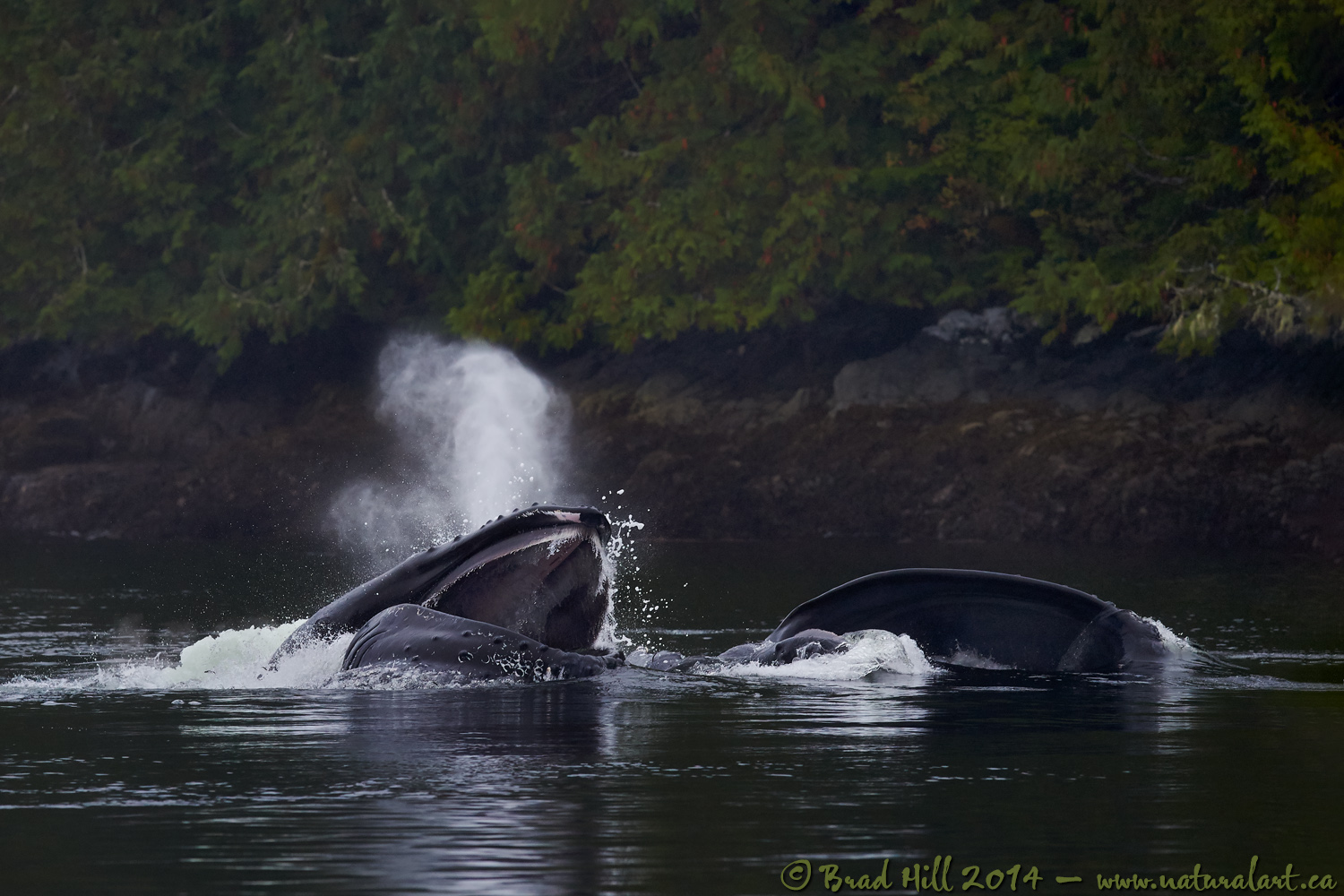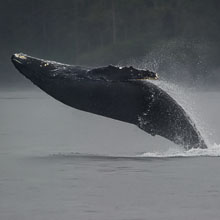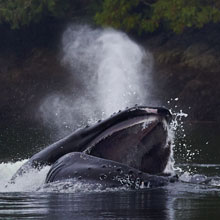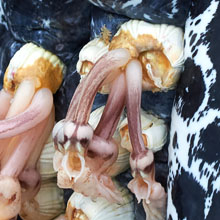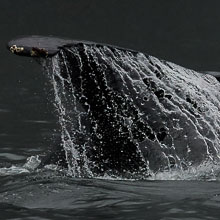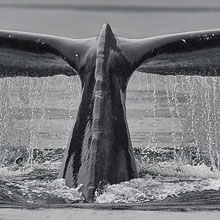Availability: Undetermined - Enquiries?
In the Field
Lunging for Lunch. Great Bear Rainforest (northern BC coast), BC, Canada. October 8, 2014.
When people who haven't visited the area hear the term "The Great Bear Rainforest" they often conjure up images of a rainy forest just teeming with bears. In some respects that's not incorrect, but in a way it sells the Great Bear Rainforest short - the forest there is filled with far more than bears, and the narrow inlets of the area are absolutely alive with amazing creatures as well. In recent years Humpback Whales have rebounded phenomenally, and each year they're becoming better and better at "stealing the show" from the bears as the key attraction!
In the Great Bear you tend to see humpbacks using one of two ways to surface feed - bubble-netting and lunging. Bubble-netting is a complex, learned behavior where one or more whales swim in a circle under a school of bait-fish while releasing bubbles from their blowhole, which forms a curtain around the feed and keeps it constrained. The whales then swim upward in the middle of the bubble-net and grab a mouthful of feed at the surface. It's an amazing spectacle to behold!
With lunge-feeding the whales simply come up from below a school of feed and, at the surface, lunge forward and use their massive mouths to trap the fish before straining the water out through their fine baleen plates (which filter the fish out).
This shot shows a pair of humpbacks lunge-feeding on small "bait fish"(herring and other small fish) in a narrow inlet. These two whales had begun constructing a bubble-net but part way through the process they aborted the net and simply lunged forward - and directly toward us - with mouths agape. The whale on the left is "blowing its stack" (exhaling from its blowhole) and the baleen plates on its upper jaw are clearly visible. The whale on the right is lying sideways in the water with it's large "bucket" (lower jaw) filling with water and fish. I loved the natural high-contrast scene provided by the dark colors of the whales and the near white splashing water. And, I think this may be the only frontal-view lunge-feeding while blowing shot I've ever managed to capture!
Some might like seeing a larger (higher resolution) version of this shot, so here ya go...
• Lunging for Lunch: Download 2400 pixel image (JPEG: 1.2 MB)
NOTES:
1. This image - in all resolutions - is protected by copyright. I'm fine with personal uses of it (including use as desktop backgrounds or screensavers on your own computer), but unauthorized commercial use of the image is prohibited by law. Thanks in advance for respecting my copyright!
2. Like all wildlife photographs on this website, this image was captured following the strict ethical guidelines described in The Wildlife FIRST! Principles of Photographer Conduct. I encourage all wildlife photographers to always put the welfare of their subjects above the value of their photographs.
3. This image was captured during one of my two autumn "Into the Great Bear Rainforest" photo tours in October of 2014. Each year I offer trips into two different parts of the Great Bear Rainforest as well as one to photograph aquatic mammals and oceanscapes near the northern tip of Vancouver Island. And, in selected years, I also offer photo tours to locations to capture other highly sought-after subjects, such as various owl species of the boreal forest and wildlife of Canada's Arctic. Details about these trips can be found on the Photo Tours page of this website.
Behind the Camera
Lunging for Lunch. Great Bear Rainforest (northern BC coast), BC, Canada. October 8, 2014.
Digital Capture; Compressed RAW (NEF) 14-bit format; ISO 2000.
Nikon D4s paired paired with Nikkor AF-S 400mm f2.8E VR - hand-held from sailboat. VR on and in Sport mode.
1/1250s @ f4.5; -1.0 stop compensation from "recommended" matrix-metered exposure setting.
At the Computer
Lunging for Lunch. Great Bear Rainforest (northern BC coast), BC, Canada. October 8, 2014.
RAW Conversion to 16-bit TIFF, including first-pass/capture sharpening using Phase One's Capture One Pro 8. Three raw variants (different versions of a single raw capture) processed, differing by a total of 0.5 stops in exposure.
Further digital corrections on resulting 16-bit TIFF files using Adobe's Photoshop CC 2014 and Light Crafts Lightzone. Photoshop adjustments included compositing (blending) of the three output files from the raw converter, selective colour desaturation, and selective sharpening for web output. Final tweaking of white-on-white detail of the splashing water and expelled "blow" water performed using LightZone's "tonemapper" tool.
Conservation
Lunging for Lunch. Great Bear Rainforest (northern BC coast), BC, Canada. October 8, 2014.
Ten percent of the revenue generated by this image will be donated to Raincoast*.
Species Status in Canada**: Threatened - North Pacific population (May 2003).
Humpback Whales (Megaptera novaeagnliae) are active, acrobatic whales that can throw themselves completely clear of the water (a behaviour known as breaching) and will swim on their backs with both flippers in the air. Humpbacks are large (up to 14m - or 46 feet - in length and 40 tonnes in weight) and with huge flippers.
Humpbacks are found in tropical, temperate, and sub-polar waters around the world. They are found on both the east and west coasts of North America. The North Pacific population has been estimated at between 6,000 and 8,000 individuals, but only a few hundred of these are found in the waters off the coast of British Columbia.
While Humpbacks are recovering from the damage done to their populations by commercial fishing, the are still subject to a variety of threats from human activities, including becoming entangled in fishing nets, noise and chemical pollution and habitat destruction.
*The Raincoast Conservation Society (and Foundation) is an effective and efficient organization that has been fighting for protection of this unique habitat. If you are looking for a meaningful way to contribute to the conservation of this amazing ecosystem, Raincoast will provide maximal "bang" for your conservation dollars.
**as determined by COSEWIC: The Committee on the Status of Endangered Wildlife in Canada












